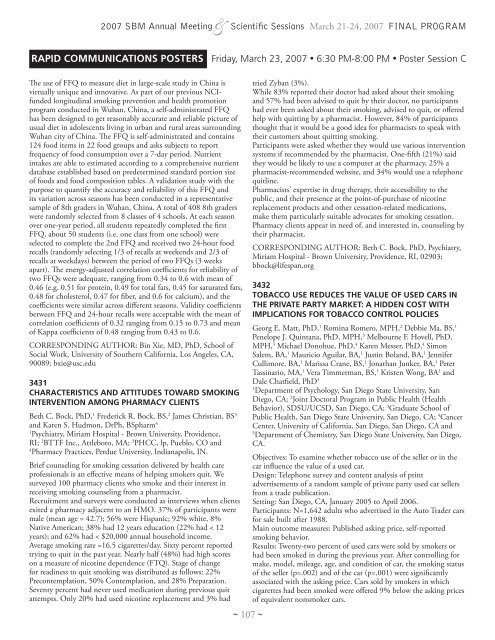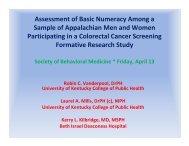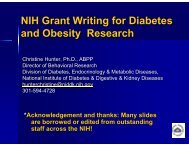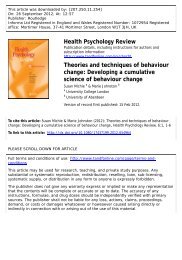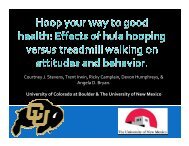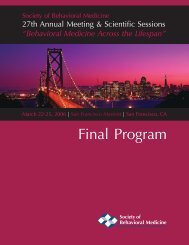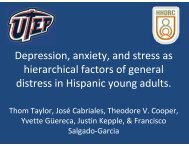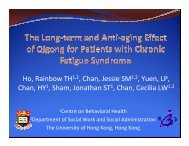2007 Final Program - Society of Behavioral Medicine
2007 Final Program - Society of Behavioral Medicine
2007 Final Program - Society of Behavioral Medicine
Create successful ePaper yourself
Turn your PDF publications into a flip-book with our unique Google optimized e-Paper software.
<strong>2007</strong> SBM Annual Meeting & Scientific Sessions March 21-24, <strong>2007</strong> FINAL PROGRAM<br />
Rapid Communications Posters Friday, March 23, <strong>2007</strong> • 6:30 PM-8:00 PM • Poster Session C<br />
The use <strong>of</strong> FFQ to measure diet in large-scale study in China is<br />
virtually unique and innovative. As part <strong>of</strong> our previous NCIfunded<br />
longitudinal smoking prevention and health promotion<br />
program conducted in Wuhan, China, a self-administrated FFQ<br />
has been designed to get reasonably accurate and reliable picture <strong>of</strong><br />
usual diet in adolescents living in urban and rural areas surrounding<br />
Wuhan city <strong>of</strong> China. The FFQ is self-administrated and contains<br />
124 food items in 22 food groups and asks subjects to report<br />
frequency <strong>of</strong> food consumption over a 7-day period. Nutrient<br />
intakes are able to estimated according to a comprehensive nutrient<br />
database established based on predetermined standard portion size<br />
<strong>of</strong> foods and food composition tables. A validation study with the<br />
purpose to quantify the accuracy and reliability <strong>of</strong> this FFQ and<br />
its variation across seasons has been conducted in a representative<br />
sample <strong>of</strong> 8th graders in Wuhan, China. A total <strong>of</strong> 408 8th graders<br />
were randomly selected from 8 classes <strong>of</strong> 4 schools. At each season<br />
over one-year period, all students repeatedly completed the first<br />
FFQ, about 50 students (i.e. one class from one school) were<br />
selected to complete the 2nd FFQ and received two 24-hour food<br />
recalls (randomly selecting 1/3 <strong>of</strong> recalls at weekends and 2/3 <strong>of</strong><br />
recalls at weekdays) between the period <strong>of</strong> two FFQs (3 weeks<br />
apart). The energy-adjusted correlation coefficients for reliability <strong>of</strong><br />
two FFQs were adequate, ranging from 0.34 to 0.6 with mean <strong>of</strong><br />
0.46 (e.g. 0.51 for protein, 0.49 for total fats, 0.45 for saturated fats,<br />
0.48 for cholesterol, 0.47 for fiber, and 0.6 for calcium), and the<br />
coefficients were similar across different seasons. Validity coefficients<br />
between FFQ and 24-hour recalls were acceptable with the mean <strong>of</strong><br />
correlation coefficients <strong>of</strong> 0.32 ranging from 0.15 to 0.73 and mean<br />
<strong>of</strong> Kappa coefficients <strong>of</strong> 0.48 ranging from 0.43 to 0.6.<br />
CORRESPONDING AUTHOR: Bin Xie, MD, PhD, School <strong>of</strong><br />
Social Work, University <strong>of</strong> Southern California, Los Angeles, CA,<br />
90089; bxie@usc.edu<br />
3431<br />
CHARACTERISTICS AND ATTITUDES TOWARD SMOKING<br />
INTERVENTION AMONG PHARMACY CLIENTS<br />
Beth C. Bock, PhD, 1 Frederick R. Bock, BS, 2 James Christian, BS 3<br />
and Karen S. Hudmon, DrPh, BSpharm 4<br />
1<br />
Psychiatry, Miriam Hospital - Brown University, Providence,<br />
RI; 2 BTTF Inc., Attleboro, MA; 3 PHCC, lp, Pueblo, CO and<br />
4<br />
Pharmacy Practices, Perdue University, Indianapolis, IN.<br />
Brief counseling for smoking cessation delivered by health care<br />
pr<strong>of</strong>essionals is an effective means <strong>of</strong> helping smokers quit. We<br />
surveyed 100 pharmacy clients who smoke and their interest in<br />
receiving smoking counseling from a pharmacist.<br />
Recruitment and surveys were conducted as interviews when clients<br />
exited a pharmacy adjacent to an HMO. 37% <strong>of</strong> participants were<br />
male (mean age = 42.7); 56% were Hispanic; 92% white, 8%<br />
Native American; 38% had 12 years education (22% had < 12<br />
years); and 62% had < $20,000 annual household income.<br />
Average smoking rate =16.5 cigarettes/day. Sixty percent reported<br />
trying to quit in the past year. Nearly half (48%) had high scores<br />
on a measure <strong>of</strong> nicotine dependence (FTQ). Stage <strong>of</strong> change<br />
for readiness to quit smoking was distributed as follows: 22%<br />
Precontemplation, 50% Contemplation, and 28% Preparation.<br />
Seventy percent had never used medication during previous quit<br />
attempts. Only 20% had used nicotine replacement and 3% had<br />
~ 107 ~<br />
tried Zyban (3%).<br />
While 83% reported their doctor had asked about their smoking<br />
and 57% had been advised to quit by their doctor, no participants<br />
had ever been asked about their smoking, advised to quit, or <strong>of</strong>fered<br />
help with quitting by a pharmacist. However, 84% <strong>of</strong> participants<br />
thought that it would be a good idea for pharmacists to speak with<br />
their customers about quitting smoking.<br />
Participants were asked whether they would use various intervention<br />
systems if recommended by the pharmacist. One-fifth (21%) said<br />
they would be likely to use a computer at the pharmacy, 25% a<br />
pharmacist-recommended website, and 34% would use a telephone<br />
quitline.<br />
Pharmacists’ expertise in drug therapy, their accessibility to the<br />
public, and their presence at the point-<strong>of</strong>-purchase <strong>of</strong> nicotine<br />
replacement products and other cessation-related medications,<br />
make them particularly suitable advocates for smoking cessation.<br />
Pharmacy clients appear in need <strong>of</strong>, and interested in, counseling by<br />
their pharmacist.<br />
CORRESPONDING AUTHOR: Beth C. Bock, PhD, Psychiatry,<br />
Miriam Hospital - Brown University, Providence, RI, 02903;<br />
bbock@lifespan.org<br />
3432<br />
TOBACCO USE REDUCES THE VALUE OF USED CARS IN<br />
THE PRIVATE PARTY MARKET: A HIDDEN COST WITH<br />
IMPLICATIONS FOR TOBACCO CONTROL POLICIES<br />
Georg E. Matt, PhD, 1 Romina Romero, MPH, 2 Debbie Ma, BS, 1<br />
Penelope J. Quintana, PhD, MPH, 3 Melbourne F. Hovell, PhD,<br />
MPH, 3 Michael Donohue, PhD, 4 Karen Messer, PhD, 4 Simon<br />
Salem, BA, 1 Mauricio Aguilar, BA, 1 Justin Boland, BA, 1 Jennifer<br />
Cullimore, BA, 1 Marissa Crane, BS, 1 Jonathan Junker, BA, 1 Peter<br />
Tassinario, MA, 1 Vera Timmerman, BS, 1 Kristen Wong, BA 1 and<br />
Dale Chatfield, PhD 5<br />
1<br />
Department <strong>of</strong> Psychology, San Diego State University, San<br />
Diego, CA; 2 Joint Doctoral <strong>Program</strong> in Public Health (Health<br />
Behavior), SDSU/UCSD, San Diego, CA; 3 Graduate School <strong>of</strong><br />
Public Health, San Diego State University, San Diego, CA; 4 Cancer<br />
Center, University <strong>of</strong> California, San Diego, San Diego, CA and<br />
5<br />
Department <strong>of</strong> Chemistry, San Diego State University, San Diego,<br />
CA.<br />
Objectives: To examine whether tobacco use <strong>of</strong> the seller or in the<br />
car influence the value <strong>of</strong> a used car.<br />
Design: Telephone survey and content analysis <strong>of</strong> print<br />
advertisements <strong>of</strong> a random sample <strong>of</strong> private party used car sellers<br />
from a trade publication.<br />
Setting: San Diego, CA, January 2005 to April 2006.<br />
Participants: N=1,642 adults who advertised in the Auto Trader cars<br />
for sale built after 1988.<br />
Main outcome measures: Published asking price, self-reported<br />
smoking behavior.<br />
Results: Twenty-two percent <strong>of</strong> used cars were sold by smokers or<br />
had been smoked in during the previous year. After controlling for<br />
make, model, mileage, age, and condition <strong>of</strong> car, the smoking status<br />
<strong>of</strong> the seller (p=.002) and <strong>of</strong> the car (p=.001) were significantly<br />
associated with the asking price. Cars sold by smokers in which<br />
cigarettes had been smoked were <strong>of</strong>fered 9% below the asking prices<br />
<strong>of</strong> equivalent nonsmoker cars.


